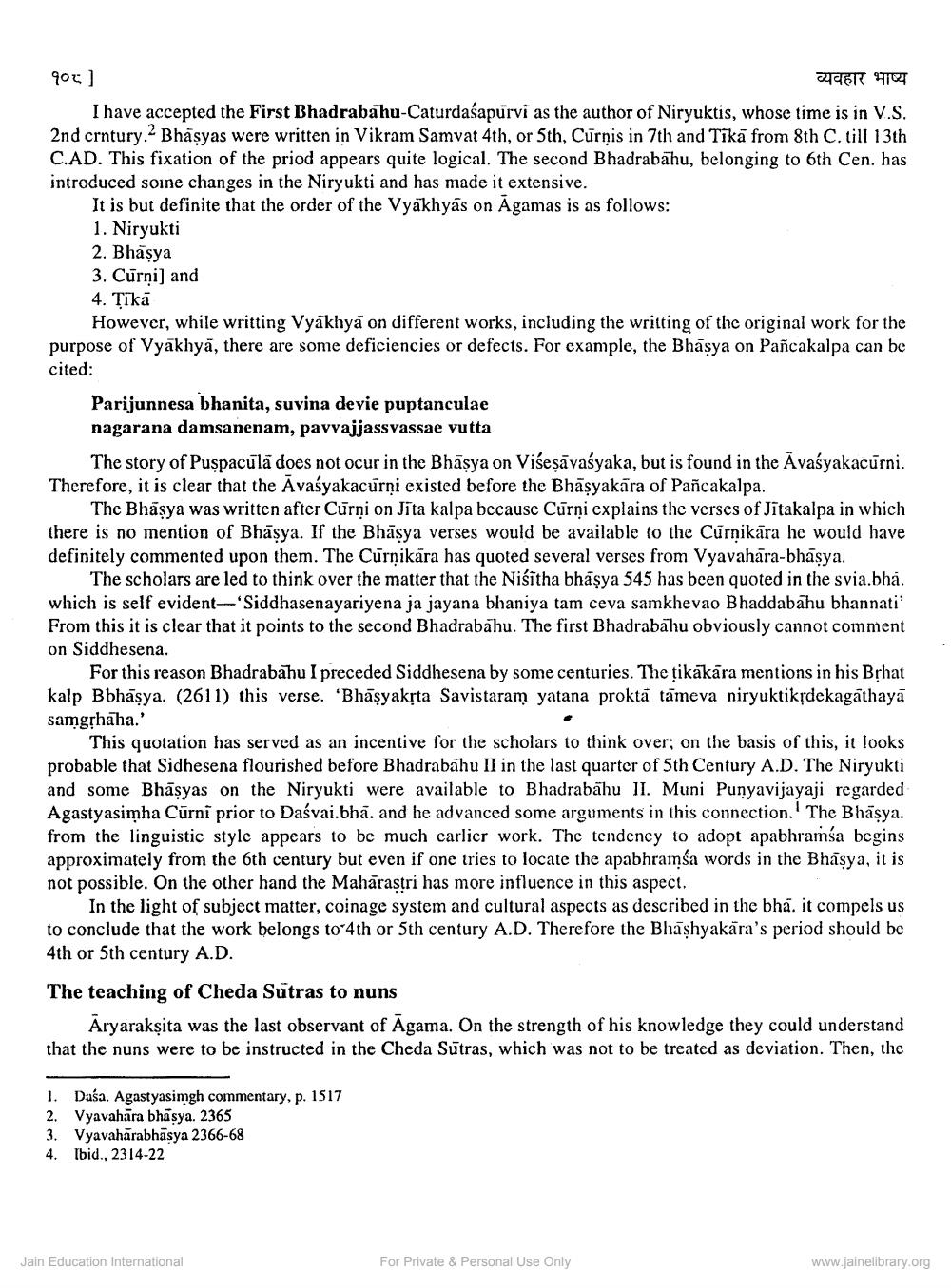________________
900]
व्यवहार भाष्य I have accepted the First Bhadrabahu-Caturdaśapurvi as the author of Niryuktis, whose time is in V.S. 2nd crntury.- Bhasyas were written in Vikram Samvat 4th, or 5th, Curnis in 7th and Tikā from 8th C. till 13th C.AD. This fixation of the priod appears quite logical. The second Bhadrabāhu, belonging to 6th Cen. has introduced soine changes in the Niryukti and has made it extensive.
It is but definite that the order of the Vyakhyas on Agamas is as follows: 1. Niryukti 2. Bhasya 3. Curni] and 4. Tikā
However, while writting Vyakhyā on different works, including the writting of the original work for the purpose of Vyakhyā, there are some deficiencies or defects. For example, the Bhasya on Pancakalpa can be cited:
Parijunnesa bhanita, suvina de vie puptanculae nagarana damsanenam, pavvajjassvassae vutta
The story of Puspacūlā does not ocur in the Bhāsya on Višeşāvaśyaka, but is found in the Avaśyakacūrni. Therefore, it is clear that the Avaśyakacurni existed before the Bhāsyakära of Pancakalpa.
The Bhāsya was written after Cūrni on Jita kalpa because Cūrni explains the verses of Jītakalpa in which there is no mention of Bhāsya. If the Bhāsya verses would be available to the Cūrnikāra he would have definitely commented upon them. The Cūrnikara has quoted several verses from Vyavahara-bhāsya.
The scholars are led to think over the matter that the Niśitha bhasya 545 has been quoted in the svia.bha. which is self evident-Siddhasenayariyena ja jayana bhaniya tam ceva samkhevao Bhaddabahu bhannati' From this it is clear that it points to the second Bhadrabahu. The first Bhadrabahu obviously cannot comment on Siddhesena.
For this reason Bhadrabahu I preceded Siddhesena by some centuries. The tikakāra mentions in his Brhat kalp Bbhasya. (2611) this verse. 'Bhasyakrta Savistaram yatana prokta tāmeva niryuktikrdekagathayā samgrhaha.'
This quotation has served as an incentive for the scholars to think over; on the basis of this, it looks probable that Sidhesena flourished before Bhadrabahu II in the last quarter of 5th Century A.D. The Niryukti and some Bhāşyas on the Niryukti were available to Bhadrabahu II. Muni Punyavijayaji regarded Agastyasimha Cūrni prior to Daśvai.bha. and he advanced some arguments in this connection. The Bhasya. from the linguistic style appears to be much earlier work. The tendency to adopt apabhramsa begins approximately from the 6th century but even if one tries to locate the apabhramsa words in the Bhāsya, it is not possible. On the other hand the Maharastri has more influence in this aspect.
In the light of subject matter, coinage system and cultural aspects as described in the bha. it compels us to conclude that the work belongs to 4th or 5th century A.D. Therefore the Bhashyakāra's period should be 4th or 5th century A.D.
The teaching of Cheda Sutras to nuns
Aryarakṣita was the last observant of Āgama. On the strength of his knowledge they could understand that the nuns were to be instructed in the Cheda Sūtras, which was not to be treated as deviation. Then, the
1. Daśa. Agastyasimgh commentary, p. 1517 2. Vyavahāra bhasya. 2365 3. Vyavaharabhāsya 2366-68 4. Ibid., 2314-22
Jain Education International
For Private & Personal Use Only
www.jainelibrary.org




